Introduction
Planet Jupiter, the largest planet in our solar system, is a colossal celestial body known for its sheer size, fierce storms, and distinctive cloud bands. This gas giant holds a special place in our cosmic neighborhood, and its features are nothing short of extraordinary. Let’s embark on a journey to unravel the wonders of Jupiter:
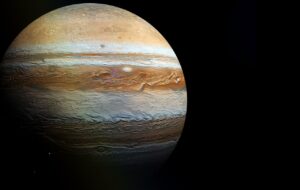
Orbital Insights
Orbit: Jupiter’s grand orbit around the Sun places it at the fifth position from our star. It rests at an average distance of about 778 million kilometers (483 million miles) from the Sun.
Rotation: Jupiter, being a gas giant, is a speedster when it comes to spinning. It completes a full rotation around its axis in approximately 9.9 hours. This rapid motion causes Jupiter to assume an oblate shape, with polar flattening and an equatorial bulge.
Planet Jupiter: Physical Wonders
Size Matters: Jupiter claims the title of the largest planet in our solar system. Its diameter stretches to approximately 139,822 kilometers (86,881 miles). In terms of mass, Jupiter outweighs all other planets, moons, asteroids, and comets in the solar system combined.
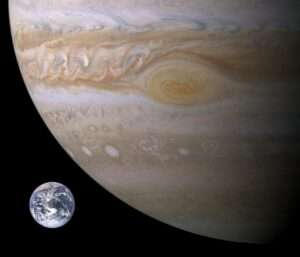
Gas Giant Identity: This colossal giant is predominantly composed of hydrogen and helium, echoing the elemental composition of the Sun. It boasts no solid surface, earning it the title of a “gas giant.”
Atmospheric Turmoil: Jupiter’s atmosphere is a realm of turbulence. Marked by prominent cloud bands, these layers of gas flow at different speeds and directions. Among these atmospheric wonders, the Great Red Spot stands out as an iconic feature. It’s a colossal storm system within a high-pressure region, sporting a distinctive reddish hue.
Noteworthy Hallmarks
Great Red Spot: Jupiter’s iconic feature, the Great Red Spot, is a gargantuan storm that has captured the attention of observers for centuries. This swirling maelstrom, characterized by its reddish appearance, can grow to several times the size of our entire planet.
Moon Mania: Jupiter boasts a vast entourage of moons, with more than 80 known, and the potential for more hidden in its cosmic embrace. Among these, the Galilean moons (Io, Europa, Ganymede, and Callisto), discovered by Galileo Galilei in 1610, are some of the largest objects in the solar system beyond the Sun and the eight planets.
Ring Revelations: Planet Jupiter possesses a subtle and narrow ring system featuring three primary components: the innermost halo ring, the central main ring, and the outermost gossamer ring.
Voyages of Exploration
Pioneer Pioneers: NASA’s Pioneer 10 and 11 ventured on the first missions to conduct flybys of Jupiter in the early 1970s, providing essential data about the planet.
Voyager Voyages: The Voyager missions, launched later in the same decade, executed flybys of Jupiter, capturing detailed images and data of Jupiter’s atmosphere and its family of moons.
Gallant Galileo: NASA’s Galileo spacecraft entered Jupiter’s orbit from 1995 to 2003, intensively examining the planet and its satellites.
Juno’s Odyssey: Launched in 2011, NASA’s Juno spacecraft has been diligently orbiting Jupiter since 2016. Its mission includes studying Jupiter’s gravitational and magnetic fields, internal structure, and composition.
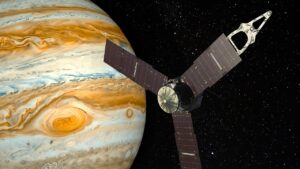
Conclusion
Finally, Jupiter’s immense size and commanding magnetic field hold substantial sway over the solar system, influencing the orbits of neighboring planets and acting as a protective guardian against potential comet and asteroid impacts. It remains a focal point of scientific study, guiding us toward a deeper understanding of gas giants and the intricate process of planetary formation.
FAQs
Q: What is Planet Jupiter’s role in the solar system?
A: Jupiter plays a crucial role in maintaining the stability of our solar system. Its massive gravitational influence helps regulate the orbits of other planets and asteroids, contributing to the overall balance of celestial bodies.
Q: Are there any signs of life on Jupiter’s moons?
A: While the possibility of life on Jupiter’s moons, particularly Europa, is a topic of scientific interest, no definitive evidence has been found. Ongoing missions and research aim to explore the potential for life-supporting conditions beneath icy surfaces.
Q: How does Jupiter’s magnetic field affect its moons?
A: Jupiter’s powerful magnetosphere influences the environment around its moons. This magnetic field interacts with the moons’ atmospheres and surfaces, shaping their geological features and contributing to the unique characteristics of each moon.
Q: What is the Great Red Spot on Jupiter?
A: The Great Red Spot is a massive storm on Jupiter, a swirling anticyclonic vortex that has persisted for centuries. Its exact cause and longevity remain subjects of scientific investigation, adding to the allure of Jupiter’s atmospheric dynamics.
Q: How does Planet Jupiter impact Earth’s climate?
A: Jupiter’s gravitational influence can affect Earth’s axial tilt over long periods, influencing climate patterns. While the impact is subtle, it contributes to the complex dynamics that shape our planet’s climate over geological timescales.
For more questions follow me on QUORA


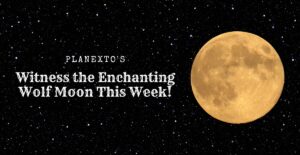
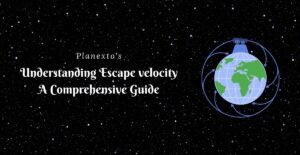


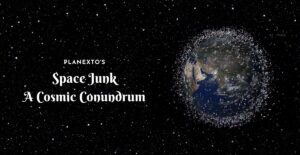
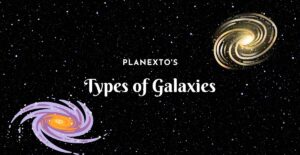
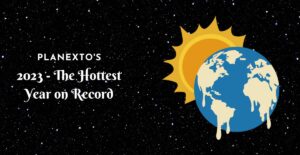
2 thoughts on “Planet Jupiter: The Mighty Giant of Our Solar System”